2008 FIAT SEDICI brakes
[x] Cancel search: brakesPage 73 of 266

72
The light should go out after starting the
engine and fully releasing the parking
brake, if the fluid level in the brake fluid
reservoir is adequate.
The light also comes on together with the
ABS warning light when the rear brake
force control function (Proportioning
valve function) of the ABS system fails.
If the brake system warning light comes
on while you are driving the vehicle, it may
mean that there is something wrong with
the vehicle’s brake system. If this happens,
you should:
❒Pull off the road and stop carefully.
❒Test the brakes by carefully starting and
stopping at the side of the road.
– If you determine that it is safe, drive
carefully at low speed to the near-
est dealer for repairs, or
WARNING AND
INDICATOR LIGHTS
BRAKE SYSTEM WARNING
LIGHT
65D477
For working check of this light, there are
following three different type operations
depending on the vehicle’s specification.
❒The light comes on briefly when the ig-
nition switch is turned to the “ON”
and/or “START” position.
❒The light comes on when the parking
brake is engaged with the ignition
switch in the “ON” position.
❒The light comes on when under either
or both of above two conditions.
The light also comes on when the fluid in
the brake fluid reservoir falls below the
specified level.
Remember that stopping dis-
tance may be longer, you
may have to push harder on the ped-
al, and the pedal may go down far-
ther than normal.
WARNING
If any of the following con-
ditions occur, you should im-
mediately ask your Fiat Dealership to
inspect the brake system.
If the brake system warning light does
not go out after the engine has been
started and the parking brake has
been fully released.
If the brake system warning light does
not come on when the ignition switch
is turned to the “ON” or “START”
position.
If the brake system warning light
comes on at any time during vehicle
operation.
WARNING
– Have the vehicle towed to the nearest
dealer for repairs.
NOTE Because the disc brake system is
selfadjusting, the fluid level will drop as the
brake pads become worn. Replenishing
the brake fluid reservoir is considered
normal periodic maintenance.
069-128 Fiat16 New GB 3-09-2008 8:19 Pagina 72
Page 132 of 266

131
PEDAL
Clutch Pedal (1)
The clutch pedal is used to disengage the
drive to the wheels when starting the en-
gine, stopping, or shifting the gearshift
lever. Depressing the pedal disengages the
clutch.
IMPORTANT Do not drive with your
foot resting on the clutch pedal. It could
result in excessive clutch wear, clutch
damage, or unexpected loss of engine
braking.
Brake Pedal (2)
Your Fiat vehicle is equipped with either
front and rear disc brakes or front disc
brakes and rear drum brakes. Depress-
ing the brake pedal applies both sets of
brakes.
You may hear occasional brake squeal
when you apply the brakes. This is a nor-
mal condition caused by environmental
factors such as cold, wet, snow, etc.Accelerator Pedal (3)
This pedal controls the speed of the en-
gine. Depressing the accelerator pedal in-
creases power output and speed.
When parking the vehicle in
extremely cold weather, the
following procedure should be used:
1) Set the parking brake.
2) Shift the manual transaxle into re-
verse or first gear, or the automatic
transaxle into “P” (Park).
3) With the engine off, get out of the
vehicle and put chocks under the
wheels.
4) Release the parking brake.
When you return to your vehicle,
you must remember to first set the
parking brake, then remove the
wheel chocks.
WARNING
(1) (2) (3)
79J072
If brake squeal is excessive
and occurs each time the
brakes are applied, you should have
the brakes checked by your Fiat
Dealership.
WARNING
Do not “ride” the brakes by
applying them continuously
or resting your foot on the pedal. This
will result in overheating of the brakes
which could cause unpredictable
braking action, longer stopping dis-
tances, or permanent brake damage.
WARNING
129-148 Fiat16 New GB 3-09-2008 8:16 Pagina 131
Page 157 of 266
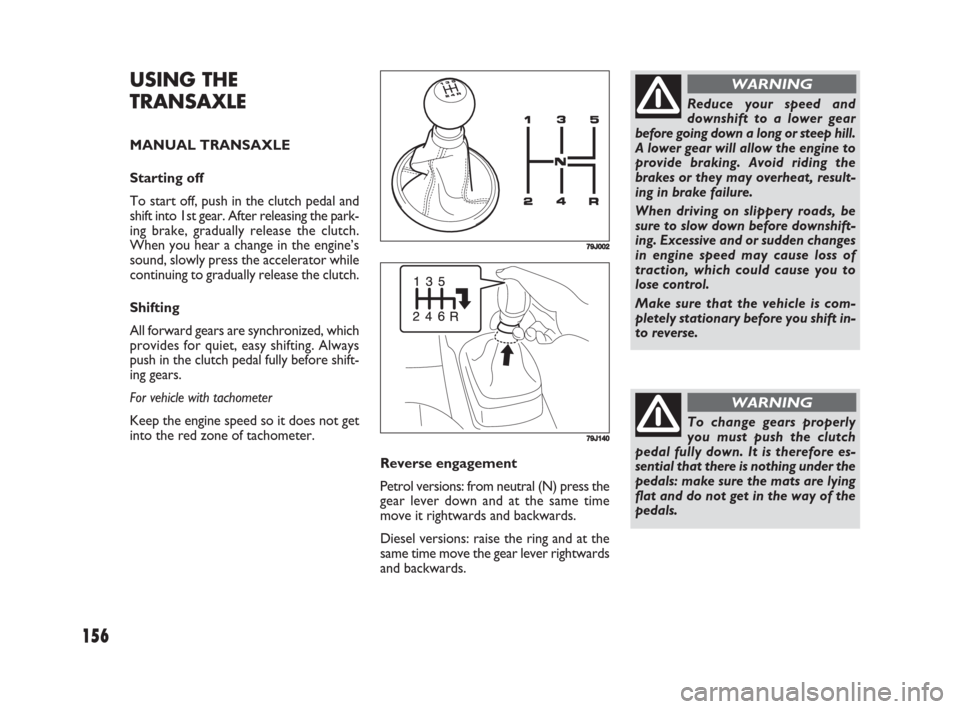
156
779J002
Reduce your speed and
downshift to a lower gear
before going down a long or steep hill.
A lower gear will allow the engine to
provide braking. Avoid riding the
brakes or they may overheat, result-
ing in brake failure.
When driving on slippery roads, be
sure to slow down before downshift-
ing. Excessive and or sudden changes
in engine speed may cause loss of
traction, which could cause you to
lose control.
Make sure that the vehicle is com-
pletely stationary before you shift in-
to reverse.
WARNING
79J140
Reverse engagement
Petrol versions: from neutral (N) press the
gear lever down and at the same time
move it rightwards and backwards.
Diesel versions: raise the ring and at the
same time move the gear lever rightwards
and backwards.
To change gears properly
you must push the clutch
pedal fully down. It is therefore es-
sential that there is nothing under the
pedals: make sure the mats are lying
flat and do not get in the way of the
pedals.
WARNING
USING THE
TRANSAXLE
MANUAL TRANSAXLE
Starting off
To start off, push in the clutch pedal and
shift into 1st gear. After releasing the park-
ing brake, gradually release the clutch.
When you hear a change in the engine’s
sound, slowly press the accelerator while
continuing to gradually release the clutch.
Shifting
All forward gears are synchronized, which
provides for quiet, easy shifting. Always
push in the clutch pedal fully before shift-
ing gears.
For vehicle with tachometer
Keep the engine speed so it does not get
into the red zone of tachometer.
149-166 Fiat16 New GB 3-09-2008 8:15 Pagina 156
Page 161 of 266
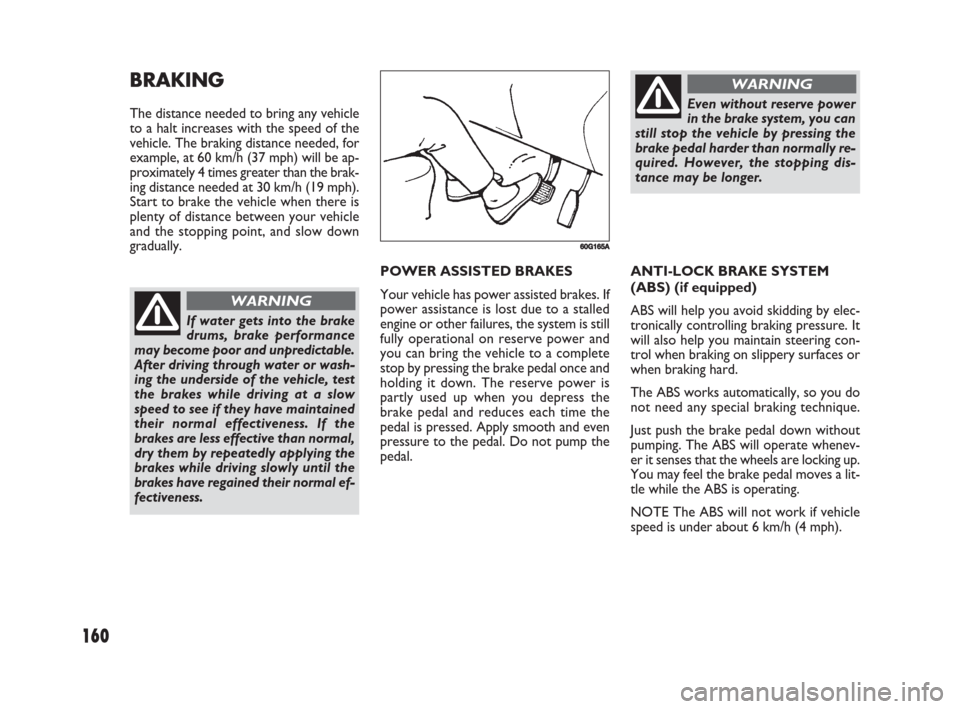
160
POWER ASSISTED BRAKES
Your vehicle has power assisted brakes. If
power assistance is lost due to a stalled
engine or other failures, the system is still
fully operational on reserve power and
you can bring the vehicle to a complete
stop by pressing the brake pedal once and
holding it down. The reserve power is
partly used up when you depress the
brake pedal and reduces each time the
pedal is pressed. Apply smooth and even
pressure to the pedal. Do not pump the
pedal.ANTI-LOCK BRAKE SYSTEM
(ABS) (if equipped)
ABS will help you avoid skidding by elec-
tronically controlling braking pressure. It
will also help you maintain steering con-
trol when braking on slippery surfaces or
when braking hard.
The ABS works automatically, so you do
not need any special braking technique.
Just push the brake pedal down without
pumping. The ABS will operate whenev-
er it senses that the wheels are locking up.
You may feel the brake pedal moves a lit-
tle while the ABS is operating.
NOTE The ABS will not work if vehicle
speed is under about 6 km/h (4 mph).
BRAKING
The distance needed to bring any vehicle
to a halt increases with the speed of the
vehicle. The braking distance needed, for
example, at 60 km/h (37 mph) will be ap-
proximately 4 times greater than the brak-
ing distance needed at 30 km/h (19 mph).
Start to brake the vehicle when there is
plenty of distance between your vehicle
and the stopping point, and slow down
gradually.
60G165A
If water gets into the brake
drums, brake performance
may become poor and unpredictable.
After driving through water or wash-
ing the underside of the vehicle, test
the brakes while driving at a slow
speed to see if they have maintained
their normal effectiveness. If the
brakes are less effective than normal,
dry them by repeatedly applying the
brakes while driving slowly until the
brakes have regained their normal ef-
fectiveness.
WARNING
Even without reserve power
in the brake system, you can
still stop the vehicle by pressing the
brake pedal harder than normally re-
quired. However, the stopping dis-
tance may be longer.
WARNING
149-166 Fiat16 New GB 3-09-2008 8:15 Pagina 160
Page 163 of 266
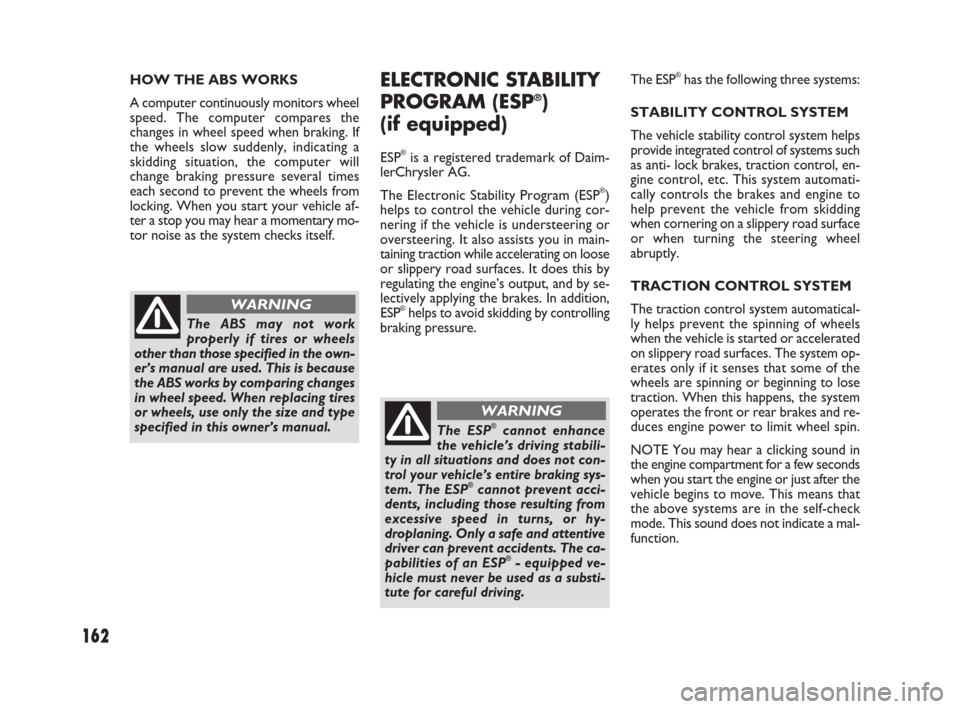
162
HOW THE ABS WORKS
A computer continuously monitors wheel
speed. The computer compares the
changes in wheel speed when braking. If
the wheels slow suddenly, indicating a
skidding situation, the computer will
change braking pressure several times
each second to prevent the wheels from
locking. When you start your vehicle af-
ter a stop you may hear a momentary mo-
tor noise as the system checks itself.
The ABS may not work
properly if tires or wheels
other than those specified in the own-
er’s manual are used. This is because
the ABS works by comparing changes
in wheel speed. When replacing tires
or wheels, use only the size and type
specified in this owner’s manual.
WARNING
ELECTRONIC STABILITY
PROGRAM (ESP®)
(if equipped)
ESP®is a registered trademark of Daim-
lerChrysler AG.
The Electronic Stability Program (ESP
®)
helps to control the vehicle during cor-
nering if the vehicle is understeering or
oversteering. It also assists you in main-
taining traction while accelerating on loose
or slippery road surfaces. It does this by
regulating the engine’s output, and by se-
lectively applying the brakes. In addition,
ESP
®helps to avoid skidding by controlling
braking pressure.
The ESP®cannot enhance
the vehicle’s driving stabili-
ty in all situations and does not con-
trol your vehicle’s entire braking sys-
tem. The ESP
®cannot prevent acci-
dents, including those resulting from
excessive speed in turns, or hy-
droplaning. Only a safe and attentive
driver can prevent accidents. The ca-
pabilities of an ESP
®- equipped ve-
hicle must never be used as a substi-
tute for careful driving.
WARNING
The ESP®has the following three systems:
STABILITY CONTROL SYSTEM
The vehicle stability control system helps
provide integrated control of systems such
as anti- lock brakes, traction control, en-
gine control, etc. This system automati-
cally controls the brakes and engine to
help prevent the vehicle from skidding
when cornering on a slippery road surface
or when turning the steering wheel
abruptly.
TRACTION CONTROL SYSTEM
The traction control system automatical-
ly helps prevent the spinning of wheels
when the vehicle is started or accelerated
on slippery road surfaces. The system op-
erates only if it senses that some of the
wheels are spinning or beginning to lose
traction. When this happens, the system
operates the front or rear brakes and re-
duces engine power to limit wheel spin.
NOTE You may hear a clicking sound in
the engine compartment for a few seconds
when you start the engine or just after the
vehicle begins to move. This means that
the above systems are in the self-check
mode. This sound does not indicate a mal-
function.
149-166 Fiat16 New GB 3-09-2008 8:15 Pagina 162
Page 169 of 266
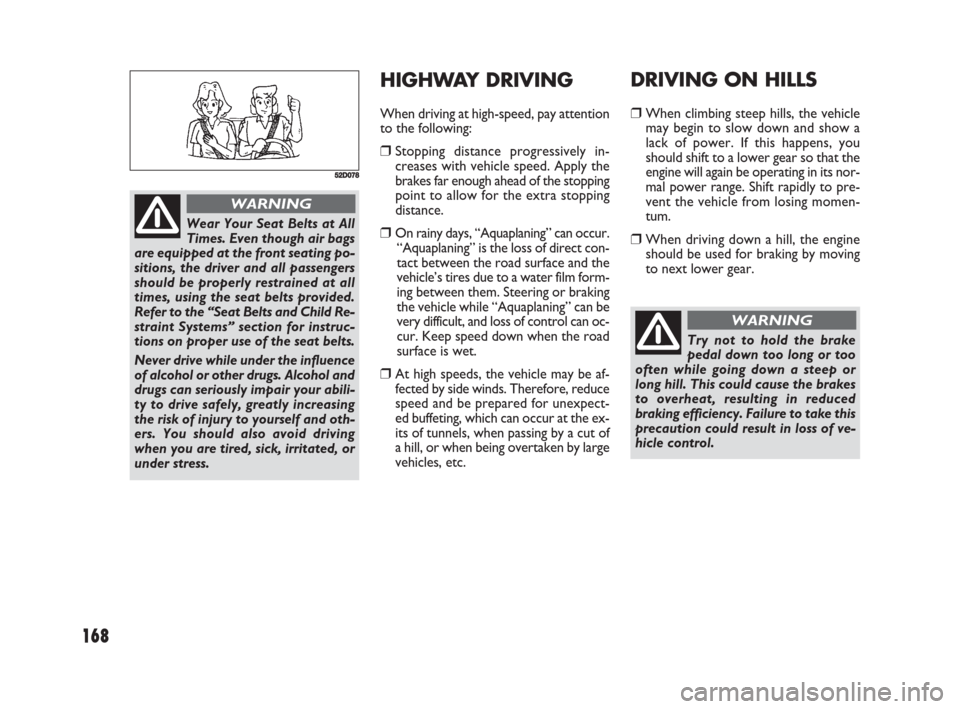
168
HIGHWAY DRIVING
When driving at high-speed, pay attention
to the following:
❒Stopping distance progressively in-
creases with vehicle speed. Apply the
brakes far enough ahead of the stopping
point to allow for the extra stopping
distance.
❒On rainy days, “Aquaplaning” can occur.
“Aquaplaning” is the loss of direct con-
tact between the road surface and the
vehicle’s tires due to a water film form-
ing between them. Steering or braking
the vehicle while “Aquaplaning” can be
very difficult, and loss of control can oc-
cur. Keep speed down when the road
surface is wet.
❒At high speeds, the vehicle may be af-
fected by side winds. Therefore, reduce
speed and be prepared for unexpect-
ed buffeting, which can occur at the ex-
its of tunnels, when passing by a cut of
a hill, or when being overtaken by large
vehicles, etc.
DRIVING ON HILLS
❒When climbing steep hills, the vehicle
may begin to slow down and show a
lack of power. If this happens, you
should shift to a lower gear so that the
engine will again be operating in its nor-
mal power range. Shift rapidly to pre-
vent the vehicle from losing momen-
tum.
❒When driving down a hill, the engine
should be used for braking by moving
to next lower gear.
52D078
Wear Your Seat Belts at All
Times. Even though air bags
are equipped at the front seating po-
sitions, the driver and all passengers
should be properly restrained at all
times, using the seat belts provided.
Refer to the “Seat Belts and Child Re-
straint Systems” section for instruc-
tions on proper use of the seat belts.
Never drive while under the influence
of alcohol or other drugs. Alcohol and
drugs can seriously impair your abili-
ty to drive safely, greatly increasing
the risk of injury to yourself and oth-
ers. You should also avoid driving
when you are tired, sick, irritated, or
under stress.
WARNING
Try not to hold the brake
pedal down too long or too
often while going down a steep or
long hill. This could cause the brakes
to overheat, resulting in reduced
braking efficiency. Failure to take this
precaution could result in loss of ve-
hicle control.
WARNING
167-170 Fiat16 New GB 3-09-2008 8:15 Pagina 168
Page 171 of 266
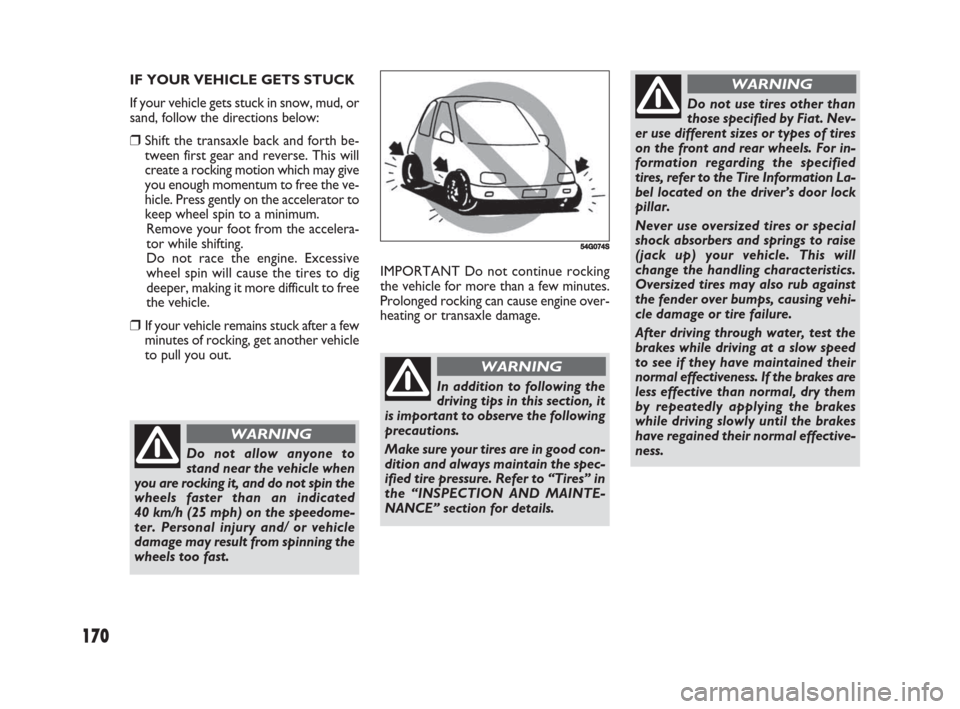
170
IMPORTANT Do not continue rocking
the vehicle for more than a few minutes.
Prolonged rocking can cause engine over-
heating or transaxle damage. IF YOUR VEHICLE GETS STUCK
If your vehicle gets stuck in snow, mud, or
sand, follow the directions below:
❒Shift the transaxle back and forth be-
tween first gear and reverse. This will
create a rocking motion which may give
you enough momentum to free the ve-
hicle. Press gently on the accelerator to
keep wheel spin to a minimum.
Remove your foot from the accelera-
tor while shifting.
Do not race the engine. Excessive
wheel spin will cause the tires to dig
deeper, making it more difficult to free
the vehicle.
❒If your vehicle remains stuck after a few
minutes of rocking, get another vehicle
to pull you out.
Do not allow anyone to
stand near the vehicle when
you are rocking it, and do not spin the
wheels faster than an indicated
40 km/h (25 mph) on the speedome-
ter. Personal injury and/ or vehicle
damage may result from spinning the
wheels too fast.
WARNING
54G074S
In addition to following the
driving tips in this section, it
is important to observe the following
precautions.
Make sure your tires are in good con-
dition and always maintain the spec-
ified tire pressure. Refer to “Tires” in
the “INSPECTION AND MAINTE-
NANCE” section for details.
WARNING
Do not use tires other than
those specified by Fiat. Nev-
er use different sizes or types of tires
on the front and rear wheels. For in-
formation regarding the specified
tires, refer to the Tire Information La-
bel located on the driver’s door lock
pillar.
Never use oversized tires or special
shock absorbers and springs to raise
(jack up) your vehicle. This will
change the handling characteristics.
Oversized tires may also rub against
the fender over bumps, causing vehi-
cle damage or tire failure.
After driving through water, test the
brakes while driving at a slow speed
to see if they have maintained their
normal effectiveness. If the brakes are
less effective than normal, dry them
by repeatedly applying the brakes
while driving slowly until the brakes
have regained their normal effective-
ness.
WARNING
167-170 Fiat16 New GB 3-09-2008 8:15 Pagina 170
Page 174 of 266
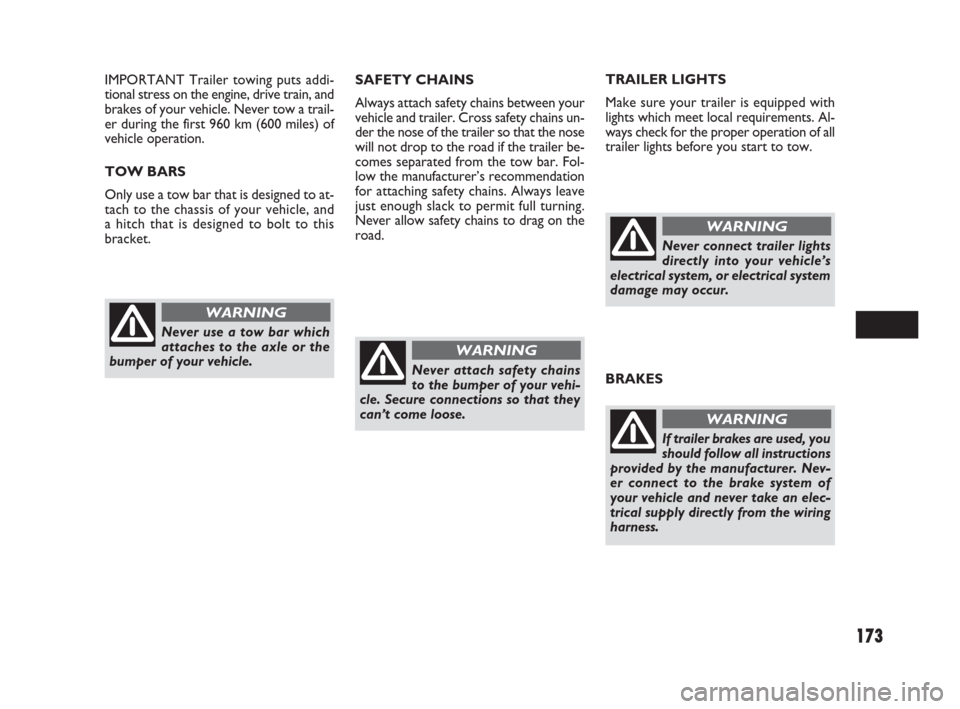
Never use a tow bar which
attaches to the axle or the
bumper of your vehicle.
WARNING
Never attach safety chains
to the bumper of your vehi-
cle. Secure connections so that they
can’t come loose.
WARNING
Never connect trailer lights
directly into your vehicle’s
electrical system, or electrical system
damage may occur.
WARNING
BRAKES
If trailer brakes are used, you
should follow all instructions
provided by the manufacturer. Nev-
er connect to the brake system of
your vehicle and never take an elec-
trical supply directly from the wiring
harness.
WARNING
173
SAFETY CHAINS
Always attach safety chains between your
vehicle and trailer. Cross safety chains un-
der the nose of the trailer so that the nose
will not drop to the road if the trailer be-
comes separated from the tow bar. Fol-
low the manufacturer’s recommendation
for attaching safety chains. Always leave
just enough slack to permit full turning.
Never allow safety chains to drag on the
road.TRAILER LIGHTS
Make sure your trailer is equipped with
lights which meet local requirements. Al-
ways check for the proper operation of all
trailer lights before you start to tow. IMPORTANT Trailer towing puts addi-
tional stress on the engine, drive train, and
brakes of your vehicle. Never tow a trail-
er during the first 960 km (600 miles) of
vehicle operation.
TOW BARS
Only use a tow bar that is designed to at-
tach to the chassis of your vehicle, and
a hitch that is designed to bolt to this
bracket.
171-180 Fiat16 New GB 3-09-2008 8:42 Pagina 173